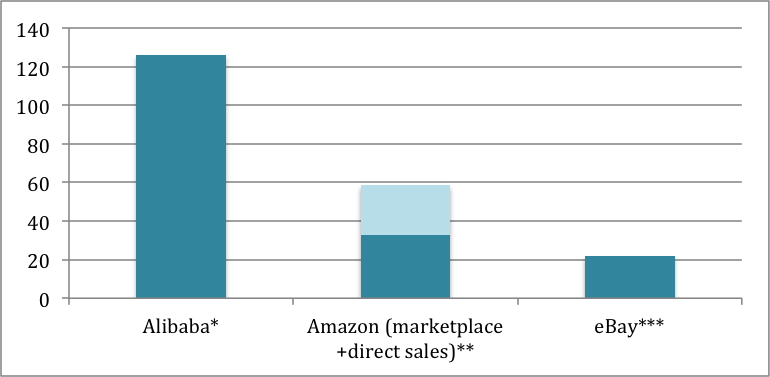I had the privilege to listen to Charles Li, CEO of the Hong Kong Stock Exchange (HKSE) at a recent conference in Singapore. He shared his views about China’s economic growth over the next few years as well as his vision and ambitions for HKSE. As someone asked him why Alibaba ended up listing on the NYSE instead of HKSE, he gave a very diplomatic answer about regulation but as he spoke I could hear pangs of regret and a hint of frustration in his voice. Who would blame him given the importance of such a high profile IPO.
Alibaba is not just a large Chinese online company…it is the world’s largest e-commerce company. Transactions on Alibaba group sites accounted for more than $300 bn last year. It’s also one of the most valuable companies with market cap of $232bn[1]. Its 3 main consumer-facing sites, Taobao.com, Tmall.com and Juhuasuan.com have over 300 million active buyers[2]. For comparison, the value of all transactions on Taobao and Tmall marketplaces were more than those of eBay and Amazon combined in Q4 2014 (see picture 1 below).
Gross Merchandise Volume (GMV), that is to say the sum of all transactions on the platforms, continued to grow in Q4 2014 at a healthy rate (close to 50% YoY[3]).
Picture 1: Gross Merchandise Volume (GMV) in $ billions, Q4 2014
*Taobao and Tmall only **Amazon marketplace GMV estimate from Channel Advisor, http://www.channeladvisor.com/blog/?pn=scot/amazons-q4-results-marketplace-surges-proves-it-is-the-amazon-profit-cow ***eBay Quarterly results, Total value of all successfully closed transactions.Alibaba’s growth has been further boosted by an exponential increase in mobile users. China’s 600 million-plus Internet users are migrating to smartphones, setting off a race to capture this new market. Alibaba’s mobile GMV now represents over 42% of a staggering 265 million mobile active users. Not bad.
With tough competition lurking (e.g. Tencent and Baidu), Alibaba has kept innovating through investments in new businesses but also by encouraging a culture of innovation and experimentation (try lots of new things, keep and scale only those that work). In a way, although it has become a goliath, this approach seems to have allowed Alibaba to retain the nimbleness of a growing start-up. Each Alibaba business is run independently and with quasi complete autonomy in order to optimise speed of decision-making and execution.
However, it would be premature to dismiss important synergies that are vital to the strength of the ecosystem. Let’s look for example at the Alibaba’s China marketplace businesses. It now consists of 3 separate businesses: Taobao, the marketplace for Chinese consumers; Tmall, the marketplace connecting Chinese consumers with brands and retailers, including international ones; and Juhuasuan.com (this is a B2C group buying platform, like Groupon)and 1688.com (this is B2B and transactional) marketplaces, respectively focused on group buying and wholesale for large Chinese businesses. While each business is run separately they critically share common features (see picture 2 below):
 Picture 2: Alibaba synergies across its platform powered ecosystem
Picture 2: Alibaba synergies across its platform powered ecosystem
Source: Launchworks Ventures
- Search
The same search engine runs across all consumer businesses – note that B2B results from 1688 do not get mixed with B2C results. This means that a search on one consumer site can also return search results across all other consumer sites. This guarantees customers complete inventory discovery and access to the long tail horizontally across all marketplaces, even when an initial search may have no/too few direct search results. The mix of search results displayed across marketplaces is decided at group level, based on priorities, relevance, supply gaps, merchant performance, etc. For example, a search on Taobao for the latest Burberry Tote bag may come back with no results on Taobao but with a relevant selection on Tmall.
- Business Intelligence
In Alibaba’s own words, “data analysis holds it together”. Dashboards on merchants & buyer health across platforms enable Alibaba to identify demand needs, supply gaps, and to reset priorities accordingly. Internal data views are able to cover both vertical market segments across its platforms and BtoBtoC dimensions. When vertical supply gaps are identified, Alibaba’s business development team can then actively recruit major brands/retailers with the specific inventory.
Let’s take the example of cross border trade, a strategic priority for Alibaba. A July 2013 study by Nielsen and PayPal estimates that the Chinese cross-border shopping market will quintuple by 2018, to $161 billion. With a rising spending power, Chinese middle class consumers have a high interest for genuine high quality western products[4]. Ordering directly from foreign websites like Amazon, Apple, and eBay would guarantee that consumers avoid the risk of paying premium prices for fake goods. But Chinese consumers face a number of barriers such as the English language, foreign payment systems and shipping services. Conversely, Western brands have had a poor presence and low traffic in China.
Alibaba’s response is the Tmall marketplace. It offers Chinese consumers access to genuine products directly from the brands and retailers themselves. For western brands and retailers it presents a good opportunity to directly access new Chinese consumers. Burberry and Apple already have shops on Tmall and even Amazon recently opened its own shop (picture 3)–although it already sells in China through its own website .
Picture 3: the Amazon store on Tmall, 10th March 2015
- Payments
Payments for goods are enabled across all 3 marketplaces (and elsewhere on and offline) by Alipay, the online payment platform. Alipay, with its escrow service (the money from the buyer is released to the seller when the goods have been received), has been a fundamental building block in establishing trust between buyers and sellers – in a same way as PayPal has helped trust for payments on eBay. Alipay is now the de-facto leading online payment platform in China with more than 300 million users.
- Cloud Computing, Internet and delivery Infrastructure
Cloud computing and Internet infrastructure services enable sellers and third party service providers (logistics, financing etc.) to build their business as part of the Alibaba’s ecosystem and be part of the marketplaces’ network effects. These ancillary services were initially developed in China but may be deployed to more territories as Alibaba’s ecosystem expands globally. Alibaba has just announced that it is bringing its cloud computing services to the US after announcing a centre in Silicon Valley. Initial plans are to target Chinese companies with business interests in the U.S., but then to ramp up its appeal to international companies from the second half of 2015.
Agreements with delivery services outside China are also being brokered (for example RoyalMail and Tmall agreement in the UK[5]) to support foreign sellers with cross border trade opportunities.
Conclusion
Alibaba is a prime example of a company that, at its heart, is built on a pure platform business model. Unlike “input/output” businesses that buy materials and resell them at a margin, Alibaba expertly enables marketplaces where users can connect, search for goods (and services), exchange, and transact.
Although each business in the group is run separately, Alibaba Group has uniquely managed to design an operating model that maximises the sharing of strategic assets. Strong enablers across its marketplaces, such as a common search engine to maximise discovery and matching between buyers and sellers, a robust business intelligence layer, a trusted payment system and ancillary services to support sellers and partners have helped overcome critical scaling issues typically associated with platforms.
Yes few businesses coming from China have been able to become global market leaders in the West. It will be interesting to see whether Alibaba can replicate its success and adapt its winning recipe to different economic, business, political and cultural environments.
Laure Claire Reillier is a Director of Launchworks Ventures and helps platform businesses design and execute winning strategies.
[1] As of 24th May 2015
[2] 334million active buyers, see Alibaba’s December 2014 quarterly results, http://www.alibabagroup.com/en/ir/presentations/pre150129.pdf
[3] see Alibaba’s December 2014 quarterly results, http://www.alibabagroup.com/en/ir/presentations/pre150129.pdf
[4] Over 60 percent of Chinese consumers say that they are willing to pay more for products labelled “Made in USA” than for those labelled “Made in China,” according to research by The Boston Consulting Group (BCG), September 2012.
[5] http://www.royalmailgroup.com/royal-mail-join-chinese-e-commerce-boom-new-alibaba-tmall-global-shop-front



